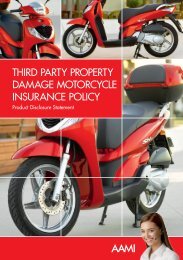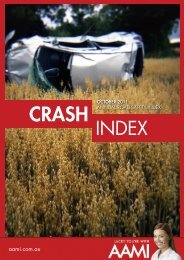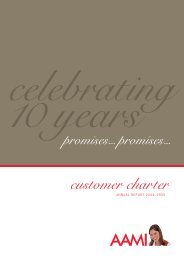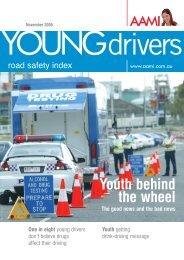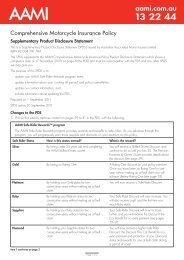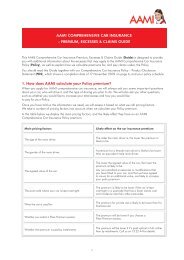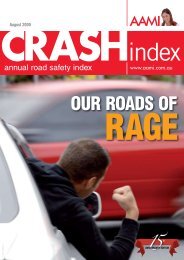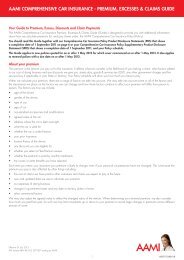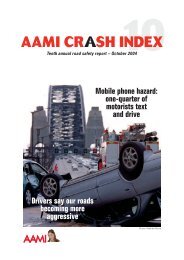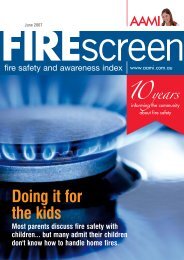Speeding - AAMI Fact Sheet Sep08
Speeding - AAMI Fact Sheet Sep08
Speeding - AAMI Fact Sheet Sep08
Create successful ePaper yourself
Turn your PDF publications into a flip-book with our unique Google optimized e-Paper software.
<strong>Fact</strong> <strong>Sheet</strong><strong>Fact</strong> <strong>Sheet</strong>speedingSEP 2008<strong>Speeding</strong> is identified as a major factor in road crashes in Australia.<strong>Speeding</strong> increases the risk and severity of a crash, as a driver hasless time to notice and react to potential hazards and they are morelikely to lose control of their vehicle.Drivers who aDmit to speeDing■ Most Australian drivers admit to exceeding the speed limit at least some of the time• Men are more likely than women to speed frequently – younger men are theworst offenders• Women aged 55 or older admit to exceeding the speed limit less often than anyother group of drivers: one in five (21 per cent) say they never exceed thespeed limit• Across the states, Victorians are slightly less likely to agree they speed most of thetime, compared to drivers in other states• Drivers who travel a large number of kilometres (20,000+ per year) more readilyadmit to speeding most of the time, as do those with 10 or fewer years’ drivingexperience (source: 2007 <strong>AAMI</strong> Crash Index)■ One-third of Australians (33 per cent) sometimes speed to arrive at work orhome sooner• Drivers who admit to this are more likely to be men, 18-34 years old, have lessdriving experience and/or drive a large number of kilometres each year(source: 2007 <strong>AAMI</strong> Crash Index)speeD Limits■ One in 10 Australians (10 per cent) agrees they often ignore restricted speed limits,such as on local and suburban roads, outside schools and around roadworks• Drivers who admit to this behaviour are more likely to be younger men, from theNorthern Territory, and drivers with up to 10 years of driving experience• Drivers who are less likely to ignore restricted speed limits are middle-aged toolder women, South Australian drivers with more than 20 years’ experience, lowannual mileage and those who have never been in a crash (source: 2007 <strong>AAMI</strong>Crash Index)■ Three-quarters of Australian drivers (76 per cent) agree that they are sometimes ‘unsureof what the speed limit is because the zones vary so much’• Drivers in Victoria and young men (18–34) are more likely to agree with thisstatement; older women drivers (more than 55 years), ACT and Northern Territorydrivers are less likely to agree (source: 2007 <strong>AAMI</strong> Crash Index)continued overleaf
<strong>Fact</strong> <strong>Sheet</strong><strong>Fact</strong> <strong>Sheet</strong><strong>Speeding</strong>ContinuedDeterrents to speeDing■ Drivers say the main reason for keeping to the speed limit is the law (32 per cent).This was followed by the ‘the deterrent of speeding fines’ (30 per cent) and ‘safety ingeneral’ (20 per cent)• Fines have the strongest impact on South Australians and the least effect onQueensland drivers or those who haven’t been in a crash (source: 2007 <strong>AAMI</strong>Crash Index)tips For ‘getting there saFeLy’1 Always stay within the designated speed limit for the section of roadyou are travelling on – and keep an eye out for any changes to thespeed limit.2 Plan your journey and allow extra travel time especially during peakperiods.3 In bad weather, reduce your speed to ensure you can brake safely andrespond to unforeseen hazards.4 Ensure there is a safe distance between your car and the vehicleahead, in case the vehicle in front needs to brake suddenly.5 Always choose a safe speed for the driving conditions – speed limitsare the maximum travel speed for any road.v



